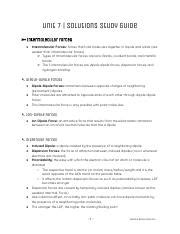Intermolecular forces are weak forces that act between molecules, holding them together in a cohesive whole. They are much weaker than intramolecular forces, which hold atoms together within a molecule. C-O intermolecular forces are a specific type of intermolecular force that occurs between molecules that contain a carbon-oxygen (C-O) bond.

Types of C-O Intermolecular Forces
There are two main types of C-O intermolecular forces:
1. Dipole-Dipole Forces:
These forces occur between molecules that have permanent dipoles. A dipole is a molecule that has two oppositely charged ends, like a magnet. In the case of C-O molecules, the oxygen atom is more electronegative than the carbon atom, so it pulls electrons toward itself, creating a partial negative charge on the oxygen atom and a partial positive charge on the carbon atom. These partial charges create a dipole, which can interact with other dipoles to form dipole-dipole forces.
2. Hydrogen Bonding:
Hydrogen bonding is a particularly strong type of dipole-dipole force that occurs when a hydrogen atom is bonded to a highly electronegative atom, such as oxygen. In the case of C-O molecules, the hydrogen atom on the water molecule is bonded to the oxygen atom on the C-O molecule. This creates a strong dipole, which can interact with other dipoles to form hydrogen bonds.
Strength of C-O Intermolecular Forces
The strength of C-O intermolecular forces depends on the following factors:
- Electronegativity of the Oxygen Atom: The more electronegative the oxygen atom, the stronger the dipole and the stronger the intermolecular forces.
- Distance Between the Molecules: The closer the molecules are to each other, the stronger the intermolecular forces.
- Temperature: As the temperature increases, the molecules move faster and the intermolecular forces become weaker.
Effects of C-O Intermolecular Forces
C-O intermolecular forces play an important role in many physical and chemical properties of substances. For example, they:
- Affect the Melting and Boiling Points: Substances with strong C-O intermolecular forces have higher melting and boiling points than substances with weak C-O intermolecular forces. This is because the intermolecular forces must be overcome in order to melt or boil the substance.
- Affect the Viscosity: Viscosity is a measure of a fluid’s resistance to flow. Substances with strong C-O intermolecular forces have higher viscosities than substances with weak C-O intermolecular forces. This is because the intermolecular forces resist the flow of the fluid.
- Affect the Solubility: Solubility is a measure of a substance’s ability to dissolve in a solvent. Substances with weak C-O intermolecular forces are more soluble in solvents with weak C-O intermolecular forces. This is because the intermolecular forces between the solute and the solvent are similar, and so the solute can easily dissolve into the solvent.
Applications of C-O Intermolecular Forces
C-O intermolecular forces have a wide range of applications, including:
- Drug Design: C-O intermolecular forces can be used to design drugs that bind to specific receptors in the body.
- Materials Science: C-O intermolecular forces can be used to create materials with specific properties, such as strength, flexibility, and resistance to heat.
- Food Science: C-O intermolecular forces can be used to improve the texture and flavor of food.
Common Mistakes to Avoid
When working with C-O intermolecular forces, it is important to avoid the following common mistakes:
- Assuming that all C-O intermolecular forces are the same. There are different types of C-O intermolecular forces, and each type has a different strength.
- Ignoring the effects of temperature. Temperature can affect the strength of C-O intermolecular forces.
- Neglecting the role of other intermolecular forces. C-O intermolecular forces are not the only type of intermolecular force that can affect a substance’s properties.
Additional Resources
Conclusion
C-O intermolecular forces are a type of weak force that can affect the properties of substances. These forces are caused by the interaction between permanent dipoles and hydrogen bonding. The strength of these forces depends on the electronegativity of the oxygen atom, the distance between the molecules, and the temperature.
